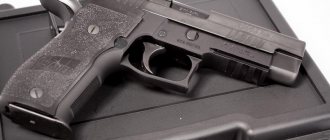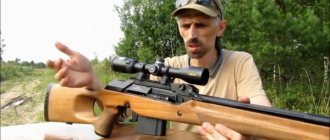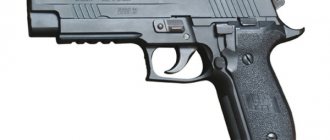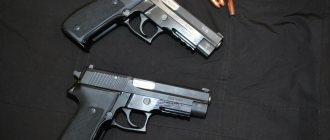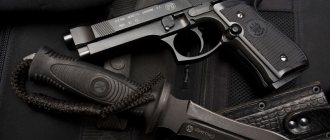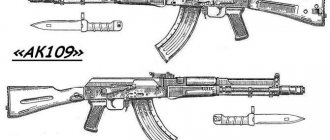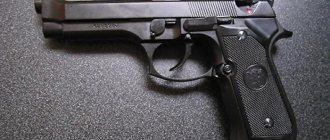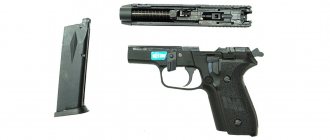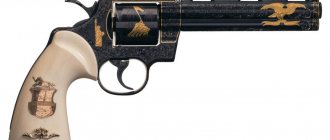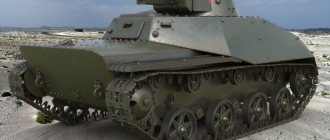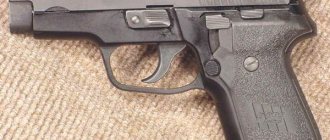The Sig Sauer p226 pistol is a Swiss weapon characterized by high quality parts processing, amazing accuracy and a considerable price. When talking about Switzerland, people immediately think of milk chocolate, reliable jars and watches. But it is worth remembering that not only peaceful professions are strong in the mountainous country. The Swiss have hundreds of firearms patents. Just remember the anti-aircraft guns that were produced under license in the USA, Britain and the Third Reich.
The P226 lost to the 92nd Beretta in the American army pistol competition. But this did not prevent sales of the German-Swiss model in the world. Where the army required low price and high technology, special forces gave preference to reliability and tactical and technical characteristics. Therefore, Zig became the ideal choice for them. Today, special forces from different countries are armed with it. Even in Russia they use P226. True, as a sports pistol and in very limited quantities.
History of creation and production
The SIG-Sauer company has existed for more than 150 years and its history began not with weapons, but with railway cars. In the mid-nineteenth century, the railway network was just beginning to entwine Europe. Traffic increased every year and more cars were needed. But soon the Swiss company refocused on the production of firearms. The fact is that in the early 1860s, the Swiss government announced a competition for a new rifle for the country's armed forces.
The sample presented by SIG was accepted into service. Very soon the gun began to be made for export. In particular, Germany became interested in him, which in those years began to slowly turn into an empire and needed a lot of modern weapons.
The prefix “Sauer” appeared shortly after the Swiss authorities passed a law stating that weapons could only be produced in the country for their own armed forces. Exports of SIG products came to a screeching halt, but management quickly resolved the issue. They simply bought a German arms factory and organized a full-fledged production of their own weapons there.
At the beginning of the twentieth century, SIG-Sauer was engaged in supplying weapons to some European countries and the United States. During the First and Second World Wars, all countries produced weapons under the SIG-Sauer license. It looked very interesting when Germany and the USSR used the same anti-aircraft gun, released under different names.
The sig sauer p226 pistol itself begins its history with the release of the 220 model, which was used by the Swiss military. Since no one has repealed the law on the production of weapons for export, and the company really wanted to take part in the American XM9 competition, the pistol was slightly redesigned and sent under the P226 marking. The competition itself was held by the US military and its goal was to adopt a 9-mm pistol that was adequate in all respects and capable of operating safely in different climatic zones.
Sig companies from all over the world took part in the competition: Beretta, Sig-Sauer, FN Herstal and others. Based on the results of the tests, two pistols reached the finals: the Italian Beretta 92 FS and the Swiss Sig-Sauer P226.
In 1984, the final winner was finally announced. It turned out to be a Beretta 92. Objectively, the P226 turned out to be better, but a number of factors played a role here. So the cost of the Italian pistol was only about 200 dollars, it was easier to master and put into production. However, according to some reports, the final choice was influenced by US policy in Europe. The Americans needed permission from the Italian authorities to place military bases and missile defense systems in the country. And Beretta’s victory became a kind of bribe to the Italian authorities.
In any case, I did not remain in the red. Representatives of various army and police special forces turned their attention to the Swiss pistol. The P226 turned out to be very successful in a number of characteristics and was ideal for professional military personnel. So the 226th was almost immediately adopted by the Delta and Navy Seals squads, and later it appeared in the hands of the SAS. The Israeli IDF did not stand aside, and closer to the 21st century, even in Kazakhstan they began to use the Sig Sauer p226 as a service weapon.
Story
The Sig Sauer P-226 pistol has its own history of creation. It all started in the late seventies of the last century. The American government has decided to replace outdated pistols in its army. A competition was announced to find the best option among all those proposed by the world's arms manufacturers.
The SIG Sauer company set its specialists the task of creating a new pistol with high combat performance. The main battle was between the Berretta M9 and P226. The American government gave preference to Italian weapons, citing the lower price of the product.
Design of the Sig Sauer p226 pistol
The Sig-Sauer P226 combat pistol was developed relatively recently. Modern types of materials are used in its production. Depending on the model, the main frame is made of weapon-grade steel, lightweight alloy or polymers. This greatly affects the weight of the weapon. Despite its size, the sig pistol weighs significantly less than the Soviet PM or Beretta m92.
P226 is created using high technology and the highest quality machines. This is what determines its high price and high reliability. There are almost no gaps in the mechanisms, so the gun must be thoroughly cleaned after each use.
The rear sight and front sight are installed on the upper edge of the receiver as the main sighting devices. On the left side there are two controls at once: the shutter stop lever and the decocker button. For safe carrying there is a safety cock and an automatic fuse. The magazine release button is located under the guard and can be reached with your index finger.
The pistol barrel is 112 mm long and has spiral rifling. The weapon is distinguished by high shot accuracy. The spread of bullets at a distance of 25 meters is only 5 cm from the center of the target. For comparison, the Soviet TT value is 15 centimeters.
Double action trigger. Combat cocking occurs when the receiver is shifted to the rearmost position or due to the trigger. It should be noted that on the P226 the hammer is cocked when a cartridge is chambered. This is very convenient in conjunction with the slide stop and speeds up bringing the pistol into combat readiness. When the safe release lever is pressed, the trigger is separated from the trigger and the weapon is locked into the safety cock. Of course, traumatic models (for example, p226t pro) do not have such features.
For the sig sauer p226 pistol, tuning is very easy and simple. There are models immediately equipped with Picatinny rails located under the barrel. A laser laser or tactical flashlight is attached to them. In some cases, an external steel frame is used, to which the shoulder rest and handle are attached. Thus, the pistol turns almost into a carbine. This modification is often used by intelligence agencies to work in confined conditions.
SIG pistols - weapons of NATO special services
SIG R.210-4
Swiss pistols bearing the SIG brand are among the best in the world. The history of this weapon goes back more than one and a half centuries. The Swiss company Schweizerische Industrie-Geselschaft (SIG) from Neuhausen was founded in 1853 by watchmaker Heinrich Moser, politician Friedrich Peyer and Swiss army officer Konrad Neuer-Stockar to manufacture steam locomotives. However, already in 1860, SIG mastered the production of muzzle-loading rifles for the Swiss army. Strong traditions, high quality products and a diverse range of weapons offered have allowed SIG to become one of the leading arms companies in the world.
In 1937, SIG bought patents from the French company SACM for a self-loading pistol designed by the Swiss gunsmith Charles Potter.
In France, this rather successful pistol was put into service in 1935 under the symbol “M.1935”. Swiss gunsmiths have significantly improved its design. This weapon, designated the Neuhausen pistol SIG M.44/8 or M.44/16 (the first group of numbers indicated the year of manufacture, the second the magazine capacity), was first presented to the command of the Swiss army in 1944. However, the pistols did not perform at their best, and SIG specialists had to start yet another improvement in their design. It was only in 1948 that the pistol went on commercial sale under the designation SIG SP 47/8. Soon it was adopted by the Swiss army under the designation “9 mm service pistol 49”. In 1957, in accordance with changes in the nomenclature of SIG pistols, SP 47/8 received a new index - P.210. SIG P.210-6
The power of the new weapon, multiplied by efficiency, as well as the highest quality of workmanship contributed to its spread, despite the extremely high cost (the retail price of one SP 47/8 pistol was $ 1,900). However, the high price did not bother potential buyers, so in the early fifties it was adopted by the Danish army, as well as by the German border guard.
In 1974, SIG signed a framework agreement with the West German arms company JPSauer & Sohn from Eckenford to purchase its shares and reassign the German subsidiary to the Swiss.
Such a merger of the research and industrial potential of the most famous arms companies contributed to strengthening the influence of Swiss gunsmiths on the international arms market and the creation of completely new, “breakthrough” designs of small arms, which were supposed to not only bring SIG to one of the leading places in the world, but also significantly increase its export potential. Now pistols developed by Swiss designers from SIG were produced in Switzerland to meet the domestic needs of the armed forces and law enforcement agencies, and for sale on the international arms market by German gunsmiths at the JPSauer & Sohn plant in Eckenford. SIG-Sauer P.220
In the mid-70s.
The Swiss army began to look for a new army pistol to replace the excellent, but very expensive SIG P.210. At the same time as the Swiss military, the governments of several other European countries, including Germany and France, announced a competition to rearm their armies and police forces with new short-barreled firearms. The military needed a weapon that, with the same combat qualities as the SIG P.210, would have a much lower cost. In 1974, SIG proposed its promising development, created on the basis of the SIG P.210 and known under the symbol P.220. The design of this pistol, created taking into account the proposals of the German company JPSauer & Sohn, turned out to be very successful. The new model was designed to use the 9x19 Parabellum pistol cartridge. The automatic operation of the P.220 pistol worked on the principle of using recoil with a short barrel stroke. The barrel bore was locked according to a modified Browning scheme, but the barrel was engaged by the casing and bolt due to the rising breech, the upper rectangular lug of which entered into an enlarged window for extracting spent cartridges. This design, first implemented in the Swiss P.220 pistol, was subsequently implemented in many other pistol models. SIG-Sauer P.225
A special feature of this pistol was the presence of a safety trigger lever. When the pistol is loaded, when the safety is turned on, the trigger is automatically removed from the sear and placed on the safety cock, without blocking the bolt. Therefore, the parts of the trigger mechanism are not locked, as in other models of pistols, which allows the shooter to open fire immediately, by self-cocking. The shape of the trigger guard is designed to hold the pistol when shooting with two hands. Sights consist of a rectangular front sight and a rear sight with a rectangular slot, adjustable horizontally. To make shooting easier in poor visibility conditions, there is a white dot on the front sight and a white frame on the rear sight. Single-row magazine with a capacity of 9 rounds.
The R.220 was chambered in several cartridges: 7.65 mm Parabellum;
9 mm “parabellum”; .38 “super” and .45 ACP. The new weapon turned out to be so successful that already in 1975 the Swiss armed forces adopted it for service under the designation “9-mm Pistole 75 pistol.” In addition, a number of these weapons were sold to the Japanese Self-Defense Forces, as well as special forces of Chile, Iran, Nigeria and Uruguay. SIG-Sauer P.226
Shortly after the creation of the SIG-Sauer P.220 pistol, in accordance with the requirements of the German Federal Police, which needed a service pistol that was safe to carry, but ready for immediate use without chambering a cartridge or working with fuses, the its shortened and lightweight model is the 9 mm SIG-Sauer P.225 pistol (18 mm shorter, 1 mm thinner and 25 grams lighter) with a magazine capacity reduced by one cartridge.
This model also featured an automatic firing pin safety and a trigger release lever. At the same time, since the shot could only occur when the trigger was pressed, the safety lever was removed from the design of the weapon, and the pistol was constantly in a state of instantaneous firing. This solution to the design of the trigger mechanism, implemented in the R.225, was the first to completely overcome the main drawback of self-loading pistols - the presence of a safety lock that delayed the firing of the first shot. The new model addressed issues of balancing and ergonomics more efficiently, which increased its combat qualities. Soon the SIG-Sauer P.225 was adopted by the Swiss police, as well as law enforcement agencies and the border police of the Federal Republic of Germany under the symbol “P 6”. A number of these pistols were purchased by the US Special Service and Special Forces. SIG-Sauer P.228
In 1980, SIG presented a sample of the SIG-Sauer P.226 pistol to a short-barreled service weapon competition held in the USA to replace the outdated Colt M.1911 A1 pistol. The design of the new pistol was based on the P.220 model and its variant SIG-Sauer P.225, improved to meet the requirements of the US Army. The new weapon was designed to use the 9x19 NATO Parabellum pistol cartridge. The perfected design of this pistol has become one of the best examples of short-barreled weapons from SIG.
In 1988, 1,500 SIG-Sauer P.226 pistols with a special SIG Lite Tritium night sight and silencer were ordered by the US FBI to arm SWAT special forces.
In addition, SIG sold the FBI a fairly large number of SIG-Sauer P.226 pistols, which replaced the operatives' weapons - 10-mm Smith-Wesson M 1076 pistols. In 1991, during Operation Desert Storm, SIG-Sauer pistols The Sauer P.226 was used by US SEALs. In 1992, they were adopted by the British SAS special forces units. Swiss pistols also entered service with the armies of New Zealand and Egypt. SIG-Sauer P.229
The desire to create a more compact version of this weapon for arming the police, as well as the desire of the SIG company to compete with the American one, which produced “mini-pistols” models 469/669, forced Swiss and German gunsmiths to develop in 1988 based on the P pistol .226 is an improved version of the SIG-Sauer P.228 with reduced dimensions and an increased capacity magazine for 13 9 mm NATO pistol cartridges.
Externally it was slightly different from its predecessor, but the internal structure of the P.228 is similar to the P.226, with the exception of a change in the configuration of some parts and the use of a new impact-resistant magazine cover. The US Armed Forces, who were looking for a compact model of short-barreled weapons to arm officers in addition to the relatively large and heavy M.9 military pistol (Beretta 92F), turned their attention to this first-class model. After a series of tests, the SIG-Sauer P.228 pistol was standardized in the American army in 1992 under the designation “9-mm compact pistol M.11”, and in 1996 it was adopted by the flight personnel of the US naval aviation and the corps of military lawyers , the FBI, the drug enforcement agency DEA, and the British Armed Forces. SIG-Sauer P.230
US law enforcement agencies considered it quite acceptable to adopt another modification of this pistol - SIG-Sauer P.229, developed in 1995 on the basis of the P.225 model for the most common cartridges on the American market: 9 mm " parabellum", .40 S&W and .357 SIG.
The most striking design differences of this model are slightly different contours of the bolt casing, a new trigger guard and the use of a new magazine. This weapon, like its predecessors, has high ballistic performance. When firing a series of five shots at a distance of 25 m, the dispersion does not exceed 50 mm. Currently, pistols of the P.229 model are adopted by municipal police in a number of US states. SIG-Sauer P.232 SL
In the same year, the last representative of the family of Swiss-German P.220 pistols was presented to the public - the new portable pistol SIG-Sauer P.239.
The task of creating a portable pistol forced the designers to noticeably round the outer contours of the bolt housing, trigger guard and pistol grip. The trigger force when firing self-cocking decreased significantly, to 4.3 kg, and with pre-cocking, to 1.8 kg. R.239 also has high ballistic performance: when firing a series of five shots at a distance of 20 m, r50 is 65-74 mm. SIG-Sauer P.239
In 1980, SIG-Sauer mastered the production of the P.230 self-loading pistol, created as a concealed police weapon. This is a small pistol of small size and weight, designed to use low-power 9x17 Kurtz and 7.65 mm Browning cartridges. In addition to the operating principle of the automation, almost all other mechanisms of the R.230 are similar to the mechanisms of the R.220 pistol. This model uses the design and layout of one of the best Walther PPK pistols, so it has smoother external contours than other pistols, which allows you to quickly and conveniently remove the weapon from a pocket or holster in emergency situations. The SIG-Sauer P.230 pistol enjoyed great success and demand among law enforcement officers in both Europe and the USA.
In 1997, the factories of the Swiss company SIG and its German branch JPSauer & Sohn mastered the production of an improved model of the P.230 pistol - SIG-Sauer P.232, chambered for 7.65x17 Browning or 9x17 Kurz cartridges. This pistol is more technologically advanced and cheaper to produce. Its design remains the same, with the exception of minor changes in the external contours of the shutter casing. This weapon is also intended to arm law enforcement officers as a second (spare) service pistol for concealed carry.
| TACTICAL AND TECHNICAL CHARACTERISTICS OF SIG-Sauer PISTOLS | ||||||
| Model | Caliber, mm | Total weight, kg | Overall length, mm | Barrel length, mm | Initial bullet speed, m/s | Magazine capacity, cartridge |
| SIG P 210-1 | 9×19 7.65x19 | 1,05 1,03 | 215 | 120 | 350 385 | 8 |
| SIG-Sauer P.220 (P 75) | 9×19 | 0,89 | 198 | 112 | 380 | 9 |
| SIG-Sauer P.225 (P 6) | 9×19 | 0,85 | 180 | 98 | 340 | 8 |
| SIG-Sauer P.226 | 9×19 | 1,08 | 196 | 112 | 380 | 15 |
| SIG-Sauer P.228 | 9×19 | 0,83 | 180 | 98 | 340 | 13 |
| SIG-Sauer P 229 | 10(40S&W) 9x19 | 0,99 | 180 | 98 | 402 340 | 12 13 |
| SIG-Sauer P 239 | 9х19 10(40S&W) | 0,78 | 168 | 92 | 375 | 8 |
| 357 SIG | — | 0,82 | 172 | 92 | 412 | 7 |
| SIG-Sauer P.230 | 9×17 9×18 7.65 Br | 0,51 0,51 0,46 | 168 | 92 | 275 — 305 | 7 — 8 |
| SIG-Sauer P.232 | 9×17 7.65 Br | 0,50 | 168 | 92 | 275 305 | 7 8 |
Sergey Monetchikov Photo from the author’s archive Bratishka 02-2003
Principle of operation
The automatic operation of the pistol is based on a short return stroke of the barrel under the influence of muzzle energy. After the part moves to its extreme position, the chamber is released and the spent cartridge case is ejected. On the way back, a new cartridge is grabbed from the box magazine and inserted into the chamber. At the same time, the hammer is cocked and the barrel is shifted to lock the chamber. It is worth noting that when you press the decocker, the trigger and the trigger are disconnected by lowering the sear.
The ammunition in the chamber is locked with a bolt stamped from high quality stainless steel. This ensures high locking reliability.
Reviews from experts and users
If we talk about reviews from experts and those who purchased a pistol and managed to use it, then such reviews vary greatly. Thus, some foreign experts call the pistol a “high-quality copied model” of the German Siq Sauer, and note its relatively low retail price.
As for users, some of them say that the weapon is quite reliable in use and is not much different from other examples of domestic trauma weapons, others primarily note its appearance (by the way, it is precisely thanks to its appearance that the pistol is respected among collectors), and still others even contemptuously call the P226 an “under-gun.” Here, as they say, it's a matter of taste.
However, both those and others note that disassembling and assembling a pistol is relatively simple, as is replacing its individual parts and assemblies.
In conclusion, a few words about tuning. In principle, as already noted, the design of the pistol is close to perfection of its kind, but at the same time there is no limit to perfection, and therefore some owners are trying to improve the external design of the P226 T TK-R. In particular, special linings for pistol grips are in use, with the help of which, according to amateurs, the weapon is given a particularly elegant and impressive look.
Ammunition
The P226 pistol uses a wide range of ammunition. It all depends on the weapon model and country. For example, in the USA they use all possible options for cartridges for this pistol, but in European countries everything depends on the legislation.
Basic ammunition for Sig-Sauer P226:
- 9 x 19 mm Para is the main type of cartridge for the P226 pistol. Mainly used by the army and police;
- The .40 S&W is a large caliber cartridge used by law enforcement agencies. Very well suited for shooting using PBS;
- .357 SIG is the Swiss company’s own cartridge, characterized by good ballistics and penetrating power.
All calibers have found their use. For example, 9 mm ammunition is widely used in sports shooting.
Traumatic
The Sig Sauer traumatic pistol is popular among athletes. The P226T TK P 10*28 model is almost entirely manufactured by SIG Sauer, only the barrel is manufactured in Russia (Izhevsk). It is forged, the manufacturers provide a guarantee for 100,000 rounds, which corresponds to its military counterpart.
The main purpose is active personal self-defense. Model features:
- the design uses the principle of freewheel recoil;
- 10X28 caliber cartridge (with rubber bullet);
- two-row store;
- high accuracy of fire;
- The sight fittings are open and equipped with white contrasting inserts;
- it is possible to install a tactical flashlight and laser laser;
- sight rear sight - on the bolt;
- the product has a wear-resistant coating;
- can be used at temperatures from -200 to +500;
- there is an overlap in the barrel that does not allow firing a solid bullet;
- the barrel cannot be removed from the bolt.
The weapon is perfect for beginning athletes to practice hand motor skills, gripping a pistol, loading and aiming. Supplied in a shockproof sealed case. Characteristics:
- magazine - for 10 ammunition;
- caliber – 10*28;
- weight – 802 grams (without cartridges);
- height – 140mm;
- thickness – 38 mm;
- total length – 196 mm, barrel – 112 mm.
Advantages and disadvantages
The Swiss managed to create a pistol that was balanced according to its characteristics, but this did not save it from a number of shortcomings.
pros
High accuracy at a distance of up to 25 meters. Due to excellent mechanics and high-quality processing of all mechanisms, an experienced shooter can easily hit a five-centimeter target at a distance of 25 meters
Reliability and quality. Sig-Sauer pays a lot of attention to the quality of its products
Large ammunition capacity. There is a P226 variant with a 20-round magazine, which is very impressive for a personal weapon.
Decocker available. You can quickly and easily decock the pistol without unnecessary movements
Bolt stop and hammer cocking when ammunition enters the chamber
Wide scope for tuning
Minuses
High cost of each product. Good quality requires careful processing of every part, which leads to more man-hours and higher product costs.
Despite its relatively light weight, the pistol is very bulky. Especially the versions with large magazines
Each Zig consists of more than 100 parts. It is difficult to clean and disassemble
Noticeable recoil when shooting .357 Sig and .40 S&w
Models
This popular weapon has been produced in several modifications throughout its history. Below is a brief overview of them:
- pistol "Sieg Sauer P226 Tactical" - has a long barrel with a thread, a silencer can be installed on it, an under-barrel mount allows the use of a tactical flashlight and a laser target pointer;
- P226 SCT – there is an extended magazine for 9*19 caliber with 20 rounds, for .40SW – 15 rounds, used in practical shooting competitions;
- P226 ST - the pistol is made entirely of steel;
- P226 Rail – Picatinny rail (universal bracket) allows you to use a lot of additional accessories to improve shooting;
- P226 Combat - a weapon for special forces, matte body (phosphate coating), additionally equipped with a large magazine and Pakatinny rail;
- P226 Equinox - .40 SW caliber, two-tone nitron coating, abrasion resistant, highly corrosion resistant;
- P226 Elite – distinctive features: soft trigger, Picatinny rail under the barrel, Elite Dark color, equipped with a damper (device for damping vibrations);
- P226 Classic 22 – chambered in .22LR caliber, used for recreational shooting.
Modifications
The Swiss pistol sig sauer p226 is available in a variety of modifications. They mainly differ in the type of ammunition used and the countries' requirements for personal weapons. Even the American Coast Guard has developed its own modification, which is used in all states.
Main models
- P226 DAC – self-loading version with a single-cocking trigger and no decocker;
- P226 SAS – a custom version of a regular pistol with smoothed corners of the receiver and without a decocker;
- P226 Equinox – model with two-tone body treatment;
- Two-Tone - anodized frame and stainless steel casing;
- P226R – immediately equipped with a Picatinny rail located under the barrel;
- P226 Navy - created for the US Navy Marine Corps;
- P226 E2 is a modern model. Pistols with improved ergonomics.
Other models
This includes sports, pneumatic (sig sauer p226 fde) and traumatic versions of the pistol. Some of the decommissioned products are deactivated in the storage facility.
- SL Sport II, X5, x6 – sports models based on the combat model;
- sig sauer p226 fde - air pistol, caliber 4.5 - mm;
- sig sauer p226t pro or p226 tk - traumatic model chambered for 10x cartridge. Considered one of the most powerful in the world;
- P226 Hunting – pneumatic.
CONTENT
- 1 History 1.1 1853: Creation of the Schweizerische Waggon Fabrik (SWF)
- 1.2 1864: SWF changes in Schweizerische Industrie Gesellschaft (SIG)
- 1.3 1976: SIG creates SIG Sauer GmbH
- 1.4 1985: SIG creates SIGARMS Inc.
- 1.5 2000: SIG sells all of its firearms interests to L&O.
- 1.6 2004: SIGARMS expands to AR-15
- 1.7 2007: SIGARMS changes name to SIG Sauer Inc.
- 1.8 2015: SIG Sauer Inc expands its range of air guns
- 1.9 2016: SIG Sauer Inc offers modular pistol system USA
- 1.10 2022: SIG Sauer Inc won the tender
- 1.11 2022: Popularity of SIG Sauer Inc in Los Angeles
- 1.12.2022 SIG Sauer Inc Airguns Division becomes SIG Air
- 1.13 2022: Swiss Arms changes name to SIG Sauer AG
- 1.14 2022: Closing of the SIG Sauer GmbH plant
- 2.1 SIG Sauer brand 2.1.1 Semi-automatic pistols
- 2.2.1 Air pistol
Operation and combat use
The Sauer pistol is widespread in the world and can be found in the most unexpected countries and organizations. For example, the Bulgarian NSO or Kazakh private security companies. The pistol is used by Austrian, French, and British special forces during assaults on houses, carriages, or air transport. Military special forces also did not stand aside. The American Navy SEALs are entirely armed with the P226.
According to unconfirmed information, the famous terrorist bin Laden was eliminated, using the Swiss Sig-Sauer P226.
Advantages
In the modern arms market, the Sig Sauer is a pistol that is a worthy competitor to the Italian Berretta and the Austrian Glock. In its 9mm class it stands out:
- voluminous ammunition (box magazines for 12-20 rounds, depending on the modification);
- high technology;
- reliability;
- resistance to external pollution;
- accuracy and shooting accuracy.
Some modifications can be equipped with a laser target pointer and a tactical flashlight. The Sauer P226 is a clear example of the German weapons school: exceptional quality and proven technology.
- a pistol that is still attractive for production. Interest in weapons is not decreasing. Today it is manufactured at SIG Sauer factories in Germany, in the US state of New Hampshire. Licensed weapons are produced in China. The successful design of the P266 has become a temptation for countries such as Iran and Myanmar, where pistols are produced without any license for their own police and armed forces.
Briefly about Sig Sauer
- The presence of a decocker is a rare element that separates the hammer and the trigger;
- Complete analogue of the Swiss P220;
- It is considered a weapon of professional military and elite units;
- In Lithuania, the pistol received the nickname - the weapon of businessmen, for the love of this category of citizens to buy P226;
- Firms operating under exist in a number of countries;
- The E2 model is made using nitrine technology;
- The Israeli IDF is slowly replacing the P226 with the promising Glock 17;
- E2 – means “improved ergonomics”.
